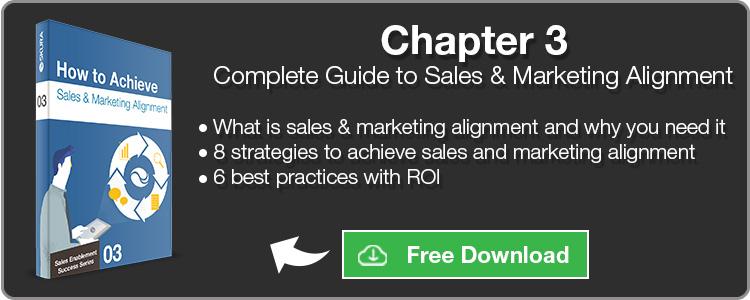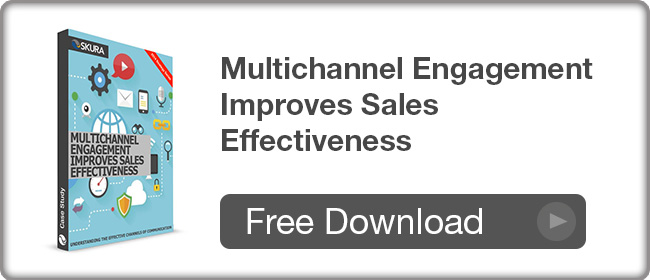In an earlier post I took an introductory look into Omni-channel engagement. This week we expand on Omni-channel engagement by looking at some of the challenges of Multi-channel engagement, how Omni-channel engagement can be beneficial, and how sales enablement can help you achieve Omni-channel engagement.
Background
We are all guilty of being constantly connected to multiple platforms through multiple devices. We have access to every platform (email, social media, video, etc.) through any device. According to reports, 98% of Americans switch between multiple devices in the same day (Source: One Reach, 2015). While you may not have considered it on a day-to-day basis, the revolutionary way that we now communicate and consume content has a huge impact on business. The unrelenting emergence of new technology means that brands must be everywhere at all times (Source: TWW News, 2014).
A prime example of a technology that has enabled us to communicate across any and all platforms is the smart phone. In fact, many attribute the smart phone to the birth of Omni-channel engagement. Devices like the smart phone have put consumers ahead of marketers when it comes to Omni-channel communication (Source: Marketo, 2014).
How can marketers get ahead of consumers today? To answer this, marketers must evaluate the way that they approach consumers through all channels. The role of the marketer now means providing a seamless experience to customers, regardless of the channel or device that they are communicating on (Source: Marketo, 2014). Therefore, each interaction of the buyer’s experience should be consistent and complimentary (Source: Marketo, 2014).
Best in class performers with the strongest Omni-channel customer engagement strategies retain an average of 89% of their customers. (Source: Aberdeen Group, 2013). Understanding how to achieve seamless engagement with your customers across all platforms will not only make the customer’s experience more enjoyable, but customers will also appreciate your customer service efforts and prefer to do business with you.
If you’re new to the subject of Omni-channel engagement and would like to learn more, may I suggest reading my previous post, Introduction to Omni-Channel Engagement for Effective Digital Sales, found here.
Challenges of Multi-channel Engagement
At this point, you might be wondering what makes Multi-channel engagement inferior to Omni-channel engagement, and you’re not alone. Multi-channel engagement can be described as an on going conversation with a customer, centered around the specific media that they consume on a regular basis (Source: Merkleinc, 2011). Using Multi-channel engagement, companies adopt two or more channels to engage with their customers; however, they are not necessarily focused on delivering a seamless and consistent message through out all channels (Source: CMO Essentials, 2014).
In reality, Multi-channel engagement can be disruptive to the customer and work against your marketing efforts. Many companies that still engage with their customers through a Multi-channel environment actually risk dividing the organization into segments based on the various channels. This means that there is a lack of communication within organizational departments, making it nearly impossible to actually achieve perfect, seamless engagement with customers. What the customer expects is a constant experience, regardless of what device they use or how the company is organized. This is where Omni-channel engagement steps in.
Unlike the Multi-channel engagement theory, Omni-channel recognizes that customers engage with companies or brands in many different ways, across multiple platforms, and addresses the challenge this creates in terms of ensuring consistency (Source: Econtent Mag, 2015). Research shows that 87% of customers agree that brands need to work harder to create a seamless experience for customers (Source: Punch Tab Insights, 2013). The Omni-channel approach works with all departments to ensure that consistency is seen throughout all marketing materials, across all channels. While Multi-channel is considered to be more of a corporate or brand view of the world based on the various channels or touch points they’ve focused on, Omni-channel is more outside in a continuation of the customer experience (Source: Target Tech, 2014).

(Image Source: Loyalty360, 2015)
Benefits of Omni-channel Engagement
Consistency
The biggest benefit of Omni-channel engagement is that it allows for the consistent facilitation of brand communications across all platforms (Source: TWW News, 2014). Having consistency across all platforms gives a stronger overall brand identity (Source: TWW News, 2014). This is especially important as today’s empowered buyer expects to receive the seamless interactions with all employees that they come in contact with. This idea aligns with the fact that 37% of customers expect to be able to contact the same customer service representative regardless of the channel that they choose to use (Source: Punch Tab Insights, 2013). The more consistent communications are across all platforms, the easier the buying decision will be for the customer.
If you find the subject of empowered buyers to be of interest, I think you may enjoy reading my previous post How an Empower Buyer Impacts the Sales Process, found here.
If you are already familiar with the subject, may I further suggest reading my previous post,, What is a Buyer Persona and How Does it Influence Digital Content, found here.
Having inconsistent engagements can also cause you to lose credibility with your customers . Inconsistent engagements from range from inaccessible content in emails to repetitive information. Customers want the information that they receive from sales reps to be up to date, and viewable. If a customer tries to open information that cannot be accessed on their device, it becomes a bigger hassle for them to either switch devices or ask for information to be resent.
Customers also like the idea of dealing with one sales rep because they don’t want to repeat information and questions that they have already addressed. According to reports, 89% of customers are frustrated by repeating their issues to multiple representatives (Source: One Reach, 2015). Customers want to continue conversations that they already had in order to help move along in their decision journey. To a customer, there is nothing than having the same conversation with a sales rep that they already had with the marketing team. This damages credibility, consistency, and wastes the customer’s time.
Data and Analytics
While using a number of different platforms to communicate with your customers may feel unnecessary at times, it is beneficial in terms of understanding consumer behaviours. You are able to capture more data if you interact with your customers on multiple platforms and this in turn equates to better insights on buying behaviour (Source: TWW News, 2014).
Gathering data from multiple platforms enriches your records and overall customer experience as it allows you to provide a closer and more personal service to (Source: TWW News, 2014). When it comes to companies using personal data, 60% of consumers agree that doing so can help to speed up important purchase decisions (Source: TWW News, 2014). The more data you can collect about where the customer stands in the decision journey, the more relatable information you can share, and the faster they will be able to make a purchase decision.
Using data and analytic software also allows you to determine the mediums which are most commonly used by customers. Knowing this information is extremely important as it will allow you to tailor content to the most popular mediums. This in turn will enhance lead generation as it creates a more enjoyable experience in line with the customer’s expectations.
Accessibility
We live in a society that is fast-paced and we are impatient. We want access to information and businesses easily and instantaneously. Search engines like Google give us the information that we want in an instant. Smart phones have made us accustomed to the ability to access information anywhere, and anytime. Customers expect the same thing from the companies that they do business with. They expect your information to be available and accessible across all platforms.
As a result, the more platforms you use, the more effective your Omni-channel engagements will be (Source: TWW News, 2014). However, being accessible across platforms also means that buyers expect companies will be better able to identify and actively respond to customer demands in a quick manner, in line with past interactions. (Source: TWW News, 2014).
Interested in learning more about the changing landscape of customer interactions? I suggest you read our previous post, ‘Digital Engagements are Changing the Sales Process and Buyer Behaviour”, found here.
How can Sales Enablement Help Manage Omni-channel Engagement?
As mentioned previously, Omni-channel engagement and sales enablement are cut from the same cloth. Sales enablement software allows your sales reps easy access to all marketing materials while out in the field. This allows for seamless sales and marketing alignment, as marketing departments are able to ensure that the right materials are being presented to clients. From their mobile device, sales reps have access to content 24 hours a day, which makes it easy to share information with customers no matter what device they are using.
Sales and marketing alignment is becoming increasingly important in today’s business. If you’re unsure about the subject, may I suggest you read our previous post, “Why use Sales and Marketing Alignment and 5 Best Practices”, found here.
Through sales enablement, marketing and sales teams also have access to sales analytic software. Data such as what content sales reps are presenting, how long they are spending on content, and the ability to see who was present during a sales call can help you determine where your customer stands in their decision journey, as well as their preferred channels of communication.
Sales enablement software can be integrated with your current CRM system, allowing you to keep track of communication in one location. Integrating your CRM with sales enablement allows you to add value to sales presentations by tracking previous conversations and ensuring that buyers are not sent repetitive information. Having this information stored in one place also means that your sales reps can create more meaningful conversations, talking to customers about information that the client is interested in (i.e., reps may notice they spent a lot of time on one particular slide, they can shape their conversation around that information).
By utilizing sales enablement, marketing teams have stronger content management which in turn allows for the customization of marketing materials both by marketing teams and by sales reps in the field. This is especially important as the empowered buyer is more inclined to pay attention to material that they feel was customized specifically for them. In reality, through sales enablement software, sales reps only adapt the content to the customer, taking information that they know will be of interest to them This actually appears individually customized in the eyes of the customer.
Interested in learning more about sales enablement software? Don’t know where to start? May I suggest reading my previous post, “How to Determine the Right Sales Enablement Software”, found here.
Best-in-class performers understand the importance of creating seamless lines of communication across all platforms with their customers. Understanding effective use of Omni-channel engagement can help you to achieve this as well.
[RELATED CONTENT] If you found this post interesting, I suggest you have a look at our white paper, “Multi-channel Engagement Improves Sales Effectiveness”.












